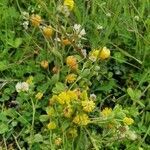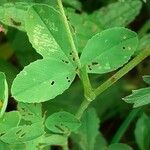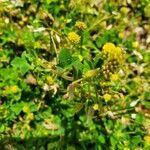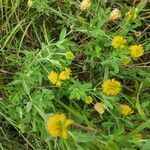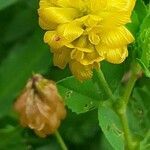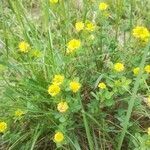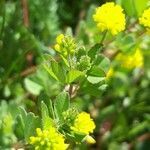Annual or biennial; stems moderately to densely clothed in appressed hairs, erect, not rooting at nodes. Lvs ± glabrous or sparsely hairy on petioles; petioles c. (3)-5-15 mm long; leaflets obovate-oblong to elliptic, obtuse to slightly emarginate, occasionally mucronate, cuneate at base, finely serrate, c. 7-20 mm long; lateral veins thin and straight to leaflet margin; petiolules < 1 mm long, ± equal; stipules ovate-oblong, acute to acuminate. Infls axillary, racemose, cylindric, pedunculate, much > lvs; fls numerous; pedicels c. 0.5 mm long; bracts subtending fls reduced to glandular hairs. Calyx glabrous, with 5 indistinct veins, not inflated at fruiting; throat open, glabrous; calyx teeth unequal, < corolla, erect at fruiting; 2 upper teeth shorter, triangular, = or < tube; 3 lower teeth lanceolate and > tube; sinuses mostly obtuse. Corolla yellow, persistent, 6-7 mm long. Pod glabrous, straight, ± = or > calyx, c. 2 mm long, 1-seeded; seeds c. 1.5 mm diam.
Annual or biennial, much-branched, mostly erect, 2–5 dm, the stem appressed-hairy; petioles 5–12 mm, about equaling the lance-oblong stipules; lfls all sessile or nearly so, oblanceolate to obovate-oblong, 1–2 cm; heads short-cylindric, 1–2 cm, on peduncles 1–4 cm from the upper axils; pedicels 0.5 mm; fls 5–7 mm; cal strongly 2-lipped, glabrous, the tube 5-nerved, 1 mm, the lobes lance-linear, the lower 1.2–1.8 mm, the upper half as long; cor yellow, the standard obovate, conspicuously striate-sulcate in age, usually serrulate, the wings dilated, concave and somewhat spreading at the summit; 2n=16. Native of Eurasia, established as a weed along roadsides and in waste places from Nf. to B.C., to S.C. and Ark. May–Sept. (T. agrarium, a rejected name)
A herb. It grows each year from seed. It grows 20-50 cm tall. The leaves have 3 leaflets spread like fingers on a hand. The leaflets are 10-23 mm long by 5-8 mm wide. There are teeth along the edge. There are 25-40 flowers in a group.
